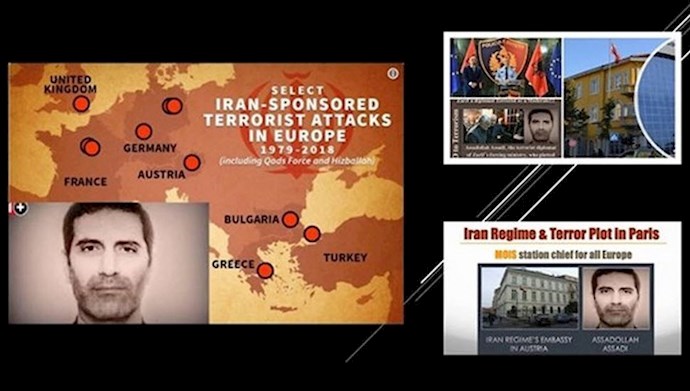It was reported last week that Assadollah Assadi, the Iranian diplomat who masterminded a terror plot in the heart of Europe three years ago, would not be pursuing an appeal of his February conviction. Assadi was prosecuted alongside three co-conspirators in a Belgian federal court and received the longest prison sentence of the group, at 20 years.
Since the start of the investigation into Assadi’s activities, he and his handlers in Tehran have maintained that he should have been granted diplomatic immunity on the basis of his position, without regard for the seriousness of the case against him. At no point have they explicitly disputed the details of that case, which include an account of him obtaining high explosives from Iran, smuggling them into Europe on a commercial flight using a diplomatic pouch, and then handing them off two an Iranian-Belgian couple tasked with carrying the bomb to the annual gathering of Iranian expatriates held just outside of Paris by the National Council of Resistance of Iran.
Assadi reportedly instructed his co-conspirators to place the device as close as possible to NCRI President-elect Mrs. Maryam Rajavi. Around six months prior to the June 30, 2018 gathering, the Iranian regime’s Supreme Leader Ali Khamenei publicly attributed a then-ongoing nationwide uprising. He specifically alleged that the People’s Mojahedin Organization of Iran (PMOI/MEK) had “planned for months” to popularize anti-government slogans and redirect initial protests away from their exclusive economic focus and toward explicit calls for regime change and democratic governance.
Concerns over this growth of influence by the MEK and NCRI apparently fueled a general increase in terrorist activity targeting the coalition’s activists and affiliates outside of Iran. The Paris terror plot was preceded in March 2018 by the attempted deployment of a truck bomb at the New Year gathering of MEK in Albania. Furthermore, in August of that same year, two Iranian nationals were indicted in the United States for conducting surveillance on MEK activists and other critics of the Iranian regime, apparently as a precursor to additional terrorist plots or assassination attempts.
Although each of these incidents led either to prosecution or to the expulsion of Iranian diplomats, they collectively underscore the fact that there is a far-reaching threat of Iranian state-sponsored terrorism which has not been addressed by Assadi’s conviction alone. Of course, that conviction is a significant step in the right direction, especially considering that Assadi was the first Iranian official to so much as face formal charges in Europe over his involvement in terrorist activity. But his trial also established that he was by no means alone in maintaining that involvement. Thus, much work remains to be done in order to uproot the terrorist networks that overlap with Iran’s diplomatic missions.
More than 220 members of the US House of Representatives acknowledged the urgency of this situation in a resolution that was recently introduced to the legislative body. H. Res. 118 “calls on relevant United States Government agencies to work with European allies… to hold Iran accountable for breaching diplomatic privileges, and to call on nations to prevent the malign activities of the Iranian regime’s diplomatic missions, with the goal of closing them down.” It also quotes a State Department official as saying in the immediate aftermath of Assadi’s arrest that “Iran uses embassies as cover to plot terrorist attacks.” Several other Western officials acknowledged this same fact at the time, and yet little apparent effort has been made to halt this practice, or even to publicly highlight Assadi’s role in it.
By declining to appeal, Assadi has effectively acknowledged that role, and it arguably does not much matter anymore whether there is widespread international awareness of his case. But the same cannot be said for international awareness of the underlying phenomenon of Iranian terrorism being channeled through embassies and other foreign institutions.
In a recent statement, members of the European Parliament from several countries described the Assadi case as leaving “no doubt about the Iranian regime’s terrorist objectives and the use of its embassies and diplomats in this regard.” It went on to suggest that the EU respond to this and other malign activities by moving to “comprehensively reassess its policy on Iran.” More specifically, it warned of likely infiltration by Iranian operatives in the guise of “diplomats, journalists or businessmen,” and it urged relevant authorities to designate the institutions behind that infiltration – the Islamic Revolutionary Guard Corps and the Ministry of Intelligence and Security – as terrorist entities.
This would indeed be an appropriate next step following the conclusion of Assadi’s case. But it must also be recognized as just another step toward a much larger goal, namely holding the entire Iranian regime accountable for its terrorist plots. In convicting Assadi, the Belgian court made it absolutely clear that he was acting at the behest of authorities high within the Iranian regime, and the NCRI has clarified that such decisions are invariably undertaken by the Supreme National Security Council, with input from the supreme leader, the president, and other leading officials.
With this in mind, the NCRI said in a recent statement that any notion of a lack of awareness by such officials “has no purpose other than to cover up state-sponsored terrorism and help the regime evade the consequences of these major crimes.” Thus, the issues underlying Assadi’s case can never be resolved until the regime’s Supreme Leader Khamenei, President Hassan Rouhani, Foreign Minister Javad Zarif, and other leading figures in the Iranian regime are all held accountable for recent terrorist attacks and historical crimes, ideally via prosecution at the International Criminal Court.
